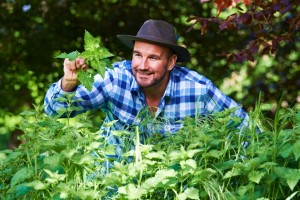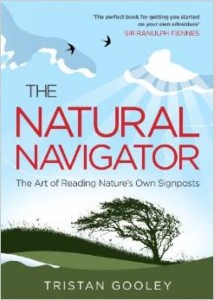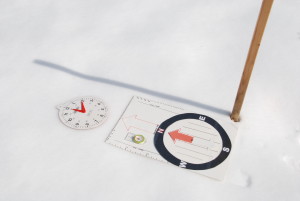Natural Navigation – Naturally
Natural Navigation – Basic Signs
Which Way? Getting Turned Around
Two Experts – Near and Afar
by Back Roads Bill
Social scientists have some very specific ideas about what you’re really saying in your Facebook updates.
In our age of technological overload, people are often tired of hearing and seeing too many photos of what others are doing every second of every day. Even your mom, at this point, probably doesn’t care what you had for dinner or after too many posters; video clips of “watch this,” moments; cats and dogs doing tricks. What are you left with?
While scrolling, it is the outdoors experiences I look for and find the most interesting amongst Facebook friends of Steer to Northern Ontario or Back Roads Bill.
Here’s one from local resident Steve Ryan Johnson, with one photo and a visual of the “slush.” “Into some pond slush snow shoeing last weekend with a group of others, we got turned around and didn’t know where we were. However D. and I had never been in the bush there and had no idea which way was home within five minutes of starting the two hour trek.” Yes, I’ve been there before, so this got me thinking. Contact was made with Steve.
Getting Lost
Steve spends a great deal of time outside and by his own volition is an “amateur naturalist.” He has some wise observations worth repeating. He said, “If you get lost in Northern Ontario you will very quickly find yourself wandering into a wetland or beaver swamp of some kind. The roads and trails were built on high ground so you get a false sense that most of the bush is dry. Then you get lost and realize that is not true.”
Steve is a believer in the compass. “I have on more than one occasion looked at my compass and simply told myself it was not working. I ‘wanted’ N, to be where I thought so strongly that I was NOT willing to believe the compass, and at the very time when it was most important to believe it.”
He reflects on techie devices. “I and many other middle aged men, have a GPS somewhere in a drawer that I took out once, could not figure out how to use, and gave up on. Many hunters and hikers return their expensive GPS to outdoor stores and demand their money back. For my generation of non-digital types, they are simply far too complicated to use; too many bells and whistles.”
He knows the tendencies of what will happen when we wander. “In general, it’s more likely you will get lost in bush that is flat. You have less reference points. I picked edible mushrooms in the mountains on Vancouver Island one fall for over a month and never got lost. There were only two directions, not four, UP and DOWN!” It is also far more likely you will get lost in softwood than hardwood simply because needle trees limit vision more. Hunters get lost far more often because they leave the trail and are totally focused on the game at the expense of location awareness.
“On a small scale, one can navigate “by white pine”. I was doing that just today. This is possible because white pines make good landmarks as they are usually interspersed among other species (excepting the rare occasions where they grow in “stands”), because mature ones stand head and shoulders above any other trees and because they are highly individualistic in appearance and you will probably remember if you have met one before. And finally, “There is NO feeling quite like being lost in the bush alone. It is in a category of fear all in its own.” True, you only have to find yourself lost to know about the feeling.” So, that got me “to thinking” some more.
Natural Navigation
For a previous story contact had been made with the author of ‘The Natural Navigator,’ “The rediscovered art of letting nature be your guide.” Tristan Gooley is the only living person to have both flown and sailed solo across the Atlantic. (Another “claim to fame,” that was last week’s story with Survivorman.) Tristan lives in the United Kingdom.
“Before GPS, before the compass, and even before cartography, humankind was navigating,” said Tristan. “We can rediscover what our ancestors long understood – that a windswept tree, the depth of a puddle or a trill of a bird song can help us find our way, if we know what to look and listen for.”
He said, “Natural navigation is the art of finding your way by using nature. It consists manly of the rare skill of being able to determine direction without of the aid of tools or instruments and only be reference to natural clues including the weather, stars plants and the movement of animals.” Hey, that’s what Steve was prophesizing about.
Tristan says, “There is a subtle difference between finding direction and knowing direction – it is sometimes possible to find direction using nature in seconds without feeling any great understanding of the natural world. To get to know direction it is necessary to have a more fundamental understanding of the world we move through.”
Navigating naturally on land is about reintroducing a childlike curiosity to the journey. “It is about learning to take note of the things that do not always appear on maps and sensations that are not easily recorded. It is about reconnecting with the land, and in doing so, keeping at bay the feelings of bewilderment and fear that getting lost can bring.” Boy, Steve was right.
Winter Signs
Even during the winter you can see lichens and mosses on trees and rocks. Tristan said, “The best to start is by challenging one of the most popular natural navigation mantras: “Moss grows on the north side of trees and buildings.” It does grow on the other side. Moss does not care about any direction, but it cares greatly about moisture. There is a direct relationship between moisture levels and the sun’s arc. If a tree or building receives and equal amount of moisture in the form of rain on all sides, on average the side facing the sun will dry out quickest. Hence moss is often happier on the moister, northern side or closer to the ground, in the northern hemisphere. Often algae are visible as the greenish tinge on the north side during the winter.
The wind organizes fresh snow into drifts and lines with one end that points “into” the prevailing wind. Fresh snow is also deposited on the leeward side of any obstacle.
Back Roads Bill’s favourite is the shadow stick. At some point near the middle of the day the sun will reach its highest point in the sky. It reaches this point at the split second it stops rising and just before it begins to set, which is another way of saying that for one tiny moment the sun is neither east nor west of you.
Tristan explained how this works, “At this important instant in each day it is directly above a line that runs from the North Pole , between your feet and on down to the South Pole. Wherever you are in the world, the shortest shadow from a stikc will always form a perfect north-south one and will this at midday (midpoint of a solar day. During the winter (and for a good portion of the globe, north of the Tropic of Cancer, including Canada). The shortest shadow in these places will always be cast towards the north, the base of shadow stick forms the southern end. The shadow is not a complex beast; it will always fall in the the opposite direction of the sun that makes it.” And for east and west, “The best method of remembering which side is east and west the sun will rise and set is to work back from the seasons. When the south pole is tilted toward the sun (our winter), the sun will rise and set south of east and west.” There are so many natural signs to learn, Steve is going down this road.
Back Roads Bill has been asked to review his upcoming book entitled ‘How To Read Water – Clues, Signs & Patterns from Puddles to the Sea,’ to be released this spring.
As Steve Ryan Johnson summarized, “Getting lost on snow shoes is never really serious ‘cuz you can always swallow your pride and follow your tracks back. Couldn’t stop laughing the next day at D’s logic, when we agreed that, it’s not like we got lost because we didn’t know where we were going in the first place. Delivered with a straight face; no, can’t argue with that.”
That’s why we have Facebook; certain posts make you think about “honest” matters off of the back roads.



